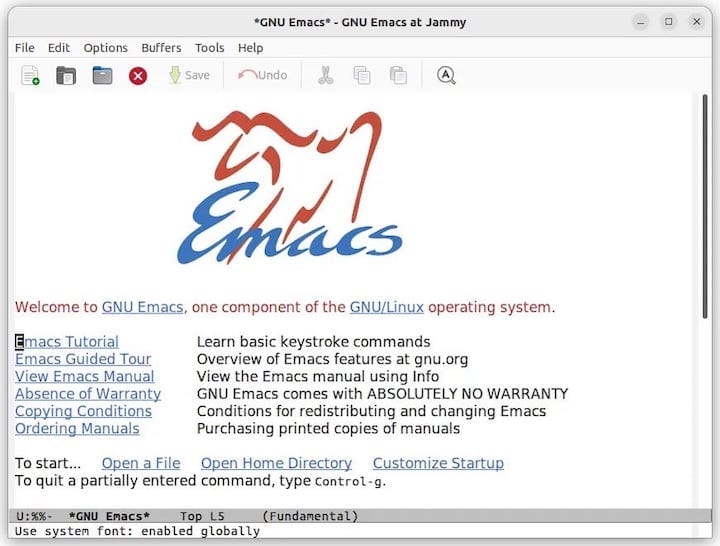How To Install Emacs Editor on Linux Mint 22

Linux Mint 22 has gained significant popularity among Linux distributions due to its user-friendly interface, stability, and robust performance. As a Linux user, having a versatile and powerful text editor is essential for various tasks, from simple note-taking to advanced programming. Emacs, with its rich history and extensive features, has been a favorite among developers and enthusiasts alike. In this article, we will guide you through the process of installing Emacs Editor on Linux Mint 22, enabling you to harness its capabilities and enhance your productivity.
Prerequisites
Before proceeding with the installation of Emacs on Linux Mint 22, ensure that your system meets the following requirements:
- A running instance of Linux Mint 22
- A non-root user account with sudo privileges
- A stable internet connection to download the necessary packages
It is also recommended to update your system to the latest available packages. Open the terminal and run the following commands:
sudo apt update
sudo apt upgradeMethods to Install Emacs on Linux Mint 22
Linux Mint provides several methods to install Emacs Editor. We will explore three common approaches: using the APT package manager, Snap packages, and the GUI Software Manager. Choose the method that best suits your needs and follow the step-by-step instructions provided.
Using APT Package Manager
The APT (Advanced Package Tool) is the default package manager in Linux Mint. It simplifies the process of installing, upgrading, and removing software packages. Follow these steps to install Emacs using APT:
Step 1: Update the System
Before installing Emacs, it’s crucial to update the package lists and upgrade any existing packages. Open the terminal and execute the following commands:
sudo apt update
sudo apt upgradeStep 2: Install Emacs
Once the system is up to date, you can proceed with installing Emacs. In the terminal, run the following command:
sudo apt install emacsAPT will resolve any dependencies and install Emacs along with the necessary packages.
Verification
To verify the successful installation of Emacs, launch it from the terminal by typing:
emacsEmacs should open, and you can start using it right away.
Using Snap Package
Snap is a universal package manager developed by Canonical, the company behind Ubuntu. It allows you to install applications in a sandboxed environment, ensuring better security and automatic updates. Here’s how to install Emacs using Snap:
Step 1: Install Snapd
Snapd is the daemon that enables Snap package management. If it’s not already installed on your Linux Mint system, you can install it by running:
sudo apt install snapdStep 2: Install Emacs using Snap
With Snapd installed, you can now install Emacs using the following command:
sudo snap install emacs --classicThe --classic flag allows Emacs to access system resources outside the sandbox.
Benefits of using Snap
Snap packages offer several advantages, such as:
- Sandboxing: Applications are isolated from the rest of the system, enhancing security.
- Automatic updates: Snap packages are automatically updated in the background, ensuring you have the latest version.
- Cross-distribution compatibility: Snaps work across different Linux distributions, making it easier to maintain consistency.
Verification
To verify the installation, launch Emacs from the terminal using the command:
emacsUsing GUI Software Manager
Linux Mint provides a user-friendly GUI Software Manager that allows you to install applications with just a few clicks. This method is particularly suitable for beginners who prefer a visual approach. Follow these steps:
Step 1: Access the Software Manager
Open the Linux Mint menu and search for “Software Manager.” Click on the icon to launch the application.
Step 2: Search and Install Emacs
In the Software Manager, use the search bar to find “Emacs.” Click on the Emacs entry and then click the “Install” button. The Software Manager will handle the installation process, including any necessary dependencies.
Advantages of using GUI for beginners
The GUI Software Manager offers several benefits for beginners:
- Ease of use: The graphical interface is intuitive and requires no command-line knowledge.
- Visual guidance: Users can browse and discover applications easily.
- Simplified process: The Software Manager handles the installation and dependency management automatically.
Verification
Once the installation is complete, you can launch Emacs from the applications menu under the “Programming” or “Accessories” category.

Post-Installation Steps
Configuration
After installing Emacs, you may want to perform some basic configuration to customize it according to your preferences. Emacs uses a configuration file called init.el, which is located in the ~/.emacs.d/ directory.
To get started, you can create a new init.el file or modify the existing one. Here are a few common configuration options:
- Setting the default font and size
- Enabling line numbers
- Configuring the color theme
- Enabling auto-save and backup
You can find numerous online resources and tutorials that provide detailed instructions on configuring Emacs to suit your needs.
Customization
One of the strengths of Emacs is its extensibility. Emacs supports a wide range of plugins and extensions that enhance its functionality and adapt it to different workflows. These extensions are written in Emacs Lisp (Elisp), a dialect of the Lisp programming language.
To explore and install extensions, you can use the built-in package manager. Press M-x (Alt+X) and type package-list-packages to open the package list. From there, you can browse, search, and install extensions that cater to your specific needs, such as language support, code completion, or project management.
Updating Emacs
To keep your Emacs installation up to date, you can use the package manager corresponding to the installation method you chose.
For APT, run the following commands in the terminal:
sudo apt update
sudo apt upgradeIf you installed Emacs using Snap, updates are handled automatically in the background. However, you can manually trigger an update by running:
sudo snap refresh emacsTroubleshooting Common Issues
While installing Emacs on Linux Mint is generally a straightforward process, you may encounter some common issues. Here are a few troubleshooting tips:
- Permission denied errors: Ensure you have the necessary permissions to install packages. Use
sudoto run commands with administrative privileges. - Package not found: Update the package lists using
sudo apt updateand try installing again. - Conflicting packages: If you encounter conflicts with existing packages, try removing the conflicting packages or using a different installation method.
Congratulations! You have successfully installed GNU emacs. Thanks for using this tutorial for installing the latest version of the GNU Emacs text editor on the Linux Mint system. For additional help or useful information, we recommend you check the official Emacs website.